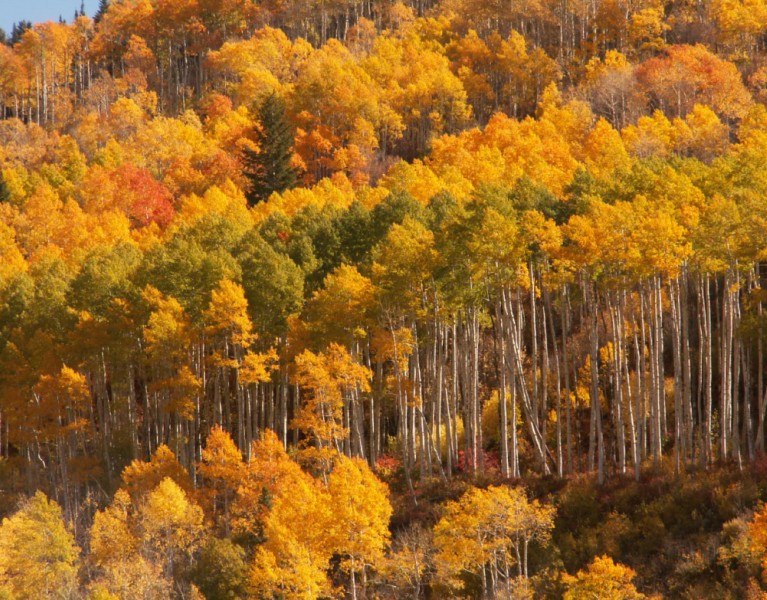
All Aglow: 5 Great Fall Foliage Hikes in the Wasatch
Table of Contents [Show]
Fall days are savory-sweet: warm in the afternoon but crisp when you return to the trailhead, with the mountains lighting up in their last showy hurrah before winter’s blanket settles in. Aspen groves turn brilliant shades of gold and red before dropping their leaves and settling in to rest until May.
We all know winter is coming, and with it all the delights of ski season. Every warm, dry day, you wonder if it will be the last before the flakes start falling. These days are in limited supply, which is why autumn hikes can be so memorable.

We in the Wasatch are lucky: Our hills are carpeted with vast groves of aspens that wait all year for their big autumnal show. If you know a bit about aspens, the experience is even cooler: aspen groves share root systems and are essentially all one connected organism. A grove can include anywhere from a handful of trunks or thousands of them—and they’re all interconnected. In fact, if you look at the patches of color blanketing the slopes of the Wasatch, you can identify each separate aspen organism as one patch of color (since each varies a bit in its leaf coloring).
So, with that, here are five great fall foliage hikes in the Wasatch: visual feasts to indulge in before the trails ice over and the first snowfalls flutter in.
1. Desolation Lake

Cradled between Big Cottonwood and Millcreek canyons, Desolation Lake makes for a stellar outing any time of year, but in autumn, the aspen-covered ridgelines above the lake light up in the afternoon light. Find the trailhead at the clear parking lot 9.3 miles up the Big Cottonwood Canyon Road, and start up the clear Mill D trailhead on the north side of the road.
You’ll soon be strolling through aspens alongside the Mill D stream, and after about a mile and a half, you’ll come to a clearly marked fork in the trail. Veer right to the Desolation Lake fork, and continue to climb up a gradual hill for another 1.9 miles until you top out at the most exquisite little lake.
This lake is not only ideal for basking in the sun and taking in the fall colors, but it’s also a perfect place to set up your tent and stay the night. You can also continue another half-mile up the switchbacks above the lake to climb all the way to the famed Wasatch Crest trail, where you can take in the entire skyline of Big Cottonwood canyon.
2. White Pine Lake
This classic Wasatch beauty lies high up in Little Cottonwood, with a clear parking-lot trailhead 5.5 miles up the canyon road. The trail steadily gains elevation but is generally a mild ascent, with just one well-marked fork in the path about a mile up. (If you hang a right and go across the stream, you go to Red Pine Lake, which is gorgeous in its own right, but isn’t our destination of the day.)
Every bit of elevation you gain, the views behind you get prettier and prettier, and you’ll work your way through countless fluttering aspens that have made the canyon their home. At the top is a cool alpine lake, and for bonus points, you can scramble higher up the scree fields to gain even more altitude and wider canyon views.
3. Stewart Falls

Many folks in Utah drive the classic Alpine Loop road come fall, but for those who would rather hike on foot, head to the Stewart Falls trail. Naturally, driving to Aspen Grove, where the trailhead is located, you’ll enjoy plenty of aesthetics. From the Grove parking lot, the trail is clear and well-marked. Plenty of people know of it, of course, so try to time your hike for an unexpected hour like early-morning or on a weekday.
The trail winds through stunning tree groves for two miles before opening up to a dramatic 200-foot waterfall cascading off the cliffs of Mt. Timpanogos. There are quite a few places to sit on the rocks near the base of the falls and take it all in. For bonus points, meander over to Sundance Resort (a walk you can tack on to your hike if you like) and grab lunch or pony up for a lift ride through even more delightful foliage.
5. Scott’s Pass
One way to sneak a view of Big Cottonwood as well as the Park City side of the Wasatch is to drive up Guardsman’s Pass, park at the tight hairpin curve where most bikers set out to ride the Wasatch Crest, and head up the trail. Just a few minutes up, you’ll arrive at a sharp, steep left that veers toward the top of Puke Hill; instead, hang a ride and scramble up the ridgeline to the top of Scott’s Bowl, which is at the top of Park City resort.
This hike is short but doesn’t hold back on vast, quality vistas of the Wasatch—enough open space to really soak in the fall colors. You can see all the way to the Uintah mountains while taking in a view of multiple ski resorts at once. Head back the way you came or explore the multiple faint trails that wander between here, Brighton, and Park City resort.
The National Forest Foundation promotes the enhancement and public enjoyment of the 193-million-acre National Forest System. By directly engaging Americans and leveraging private and public funding, the NFF improves forest health and Americans’ outdoor experiences. The NFF’s programs inform millions of Americans about the importance of these treasured landscapes. Each year, the NFF restores fish and wildlife habitat, plants trees in areas affected by fires, insects and disease, improves recreational opportunities, and enables communities to steward their National Forests and Grasslands. Learn more at www.nationalforests.org.
Originally written by RootsRated.
Featured image provided by Mike Nielsen


